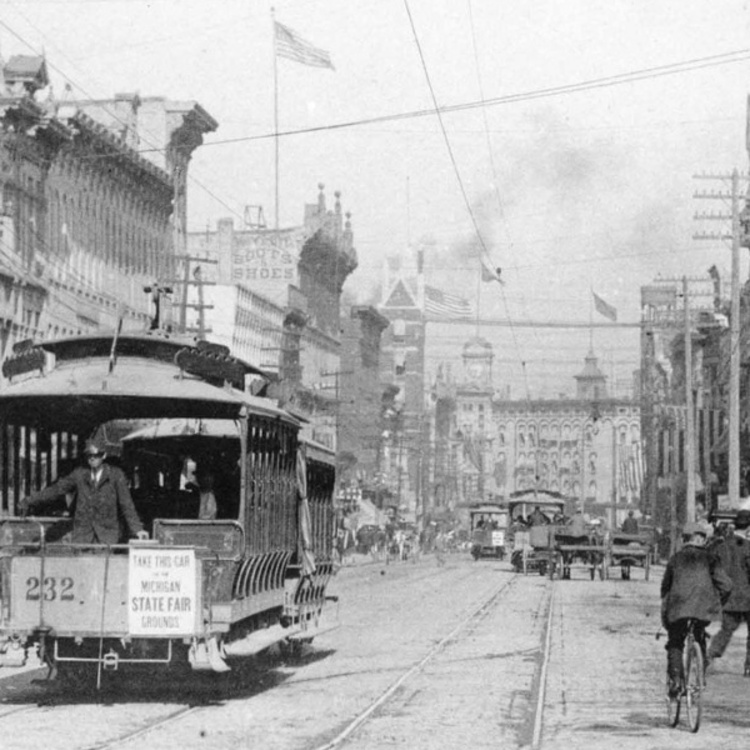History of Grand Rapids
Our recorded history stretches back two millennia and reflects the contributions of many diverse peoples. Explore our storied past at historic sites and through the following historical high points.
Native Americans
The land where Grand Rapids is situated today is the ancestral land of the Anishinaabe: the Ojibwe, Odawa and Bodéwadmi people, also known as the People of the Three Fires. They were living here longer than history can accurately record, thousands of years before the arrival of the first European settlers.
Read more about the Native American people of Grand Rapids or visit the Grand Rapids Public Museum exhibit, Anishinabek: The People of This Place, to hear their story in their own voices and view rare and fascinating artifacts.
Early Settlers
French-Canadian Joseph La Framboise and his wife Magdalene, who was of mixed Ottawa and French descent, established the first fur-trading post here in 1806. The original inhabitants of the land were displaced, often forcibly, as more settlers arrived. In 1821, leaders of the People of the Three Fires signed the Treaty of Chicago, which ceded much of the land of present-day West Michigan to the U.S. government and accelerated the colonization of much of the Great Lakes region by non-Natives.
Detroit-born Louis Campau, known as the official founder of Grand Rapids, built a trading post, blacksmith shop and cabin on the banks of the Grand River in 1826. Grand Rapids became a village in 1838 and a city in 1850.
The city grew through successive waves of immigration, first from Europe and then from around the world. The Grand Rapids Public Museum exhibit, Newcomers: The People of this Place, tells the story of the people who came after the Anishinaabe.
Explore more history by learning about the people of Grand Rapids.
Gypsum Mines
Gypsum (plaster) mining was the area’s first major industry. Commercial gypsum operation began in 1841 and there were eventually 13 separate mine operators. Our plaster was sent around the world, leading citizens to view gypsum as a "mine of apparently inexhaustible wealth to our city." The mines are no longer active and now serve as secure dry storage sites. The Mines Golf Club and Millennium Park are built atop old gypsum mines.
Furniture City
Grand Rapids became a major lumbering center in the late 19th century, processing logs that were floated down the Grand River from elsewhere in the region. The ready supply of timber led to the city’s second great industry – fine wood furniture. At the height of the lumber boom, Grand Rapids was home to 44 furniture companies and the city was recognized worldwide as America’s Furniture City. Today, our manufacturing focus has shifted away from residential furniture to office furniture, but the Heritage Hill mansions of lumber barons and furniture magnates still bear witness to a glorious era.
Railroads
The Grand Rapids and Indiana Railroad, founded in 1854, became the country’s longest north-south rail line when it provided passenger and freight services between Cincinnati, Ohio and the Straits of Mackinac, the waterway between Michigan’s Lower and Upper Peninsulas. The railroad largely ceased operation a century later – and much of the old railway, along with other abandoned rail lines, has been converted to paved biking and running trails. Downtown’s Blue Bridge, a pedestrian walkway over the Grand River, and The White Pine Trail, a linear state park spanning 92 miles from Grand Rapids to the north, are prominent examples.
Beer City
In 1836, Englishman John Pannell built a small brewery in what would become downtown Grand Rapids. The local brewing scene thrived until Prohibition and limped along thereafter – the last remaining brewery closed in 1951. Our long dry spell ended in 1997, when a pair of college classmates opened Canal Street Brewing, which was later renamed Founders Brewing Company. Founders is now the largest of 40+ local craft breweries – and Grand Rapids is now acknowledged as Beer City USA.
Health Care
In 1945, Grand Rapids became the first city in the world to fluoridate its drinking water – a move hailed as one of the 20th century’s greatest public health achievements. Local innovators went on to pioneer advances in rehabilitative care, joint implants, generic drugs and more before establishing one of the 21st century’s fastest-growing life-sciences clusters.
Historical Firsts
- 1881: America’s 1st hydro-electric plant
- 1889: America’s 1st female CEO (Anna Sutherland Bissell)
- 1926: America’s 1st regularly scheduled airline service (Grand Rapids to Detroit)
- 1945: 1st U.S. city to fluoridate its drinking water
- 1962: America’s 1st superstore (Meijer)
- 1965: America’s 1st megaplex movie theater
- 1969: 1st NEA-funded art installation (La Grande Vitesse)
- 2011: America’s 1st community-wide festival of laughter (LaughFest)
Tour covered bridges, historic homes, lighthouses and more.










